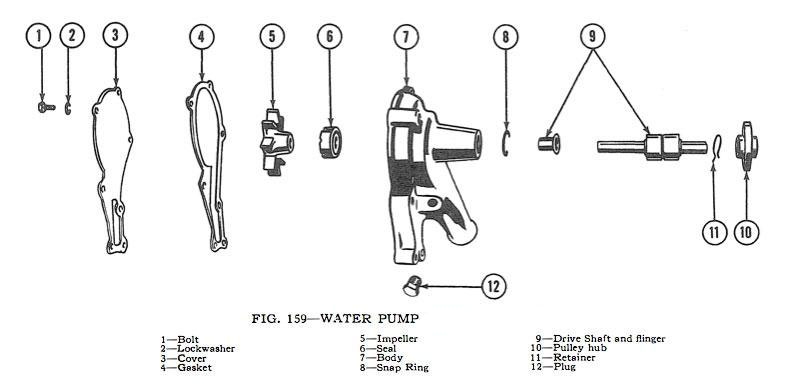Cooling Service Standards - Truck
Radiator Pressure Cap
Early production vehicles were equipped with 7 lb. [0,50 kg-cm²] pressure caps; later vehicles with 9 lb. [0,63 kg-cm²] caps. Current production Model L6-226 4WD vehicles are equipped with 13 lb. [0,91 kg-cm²] pressure caps; all others with the 9 lb. caps.
Thermostat
The standard thermostat is designed to start opening at 165°F. [74°C.] and be fully open at 188°F. [86°C.]. The optional high-temperature thermostat is designed to start opening at 180°F. [82°C.] and be fully open at 202°F. [94°C.].
Thermostat
To test the thermostat, place it in water heated approximately 25°F. [17°C.] above the temperature stamped on the thermostat valve. Submerge the bellows completely and agitate the water thoroughly. The valve should open fully. Next, place the thermostat in water heated approximately 10°F. [11 °C.] below the temperature stamped on the thermostat valve. Submerge the bellows completely and agitate the water thoroughly. The valve should close completely.
Water Pump
All L6-226 Models. The information for the water pump used on these models is covered in Par. H-15 through H-18. This pump, Fig. 159, is a centrifugal impeller type of large capacity having a hardened and ground shaft supported by sealed, lifetime lubricated ball bearings. The shaft also has a brass sleeve extending through the seal to protect against corrosion. The fan pulley hub and the cast iron impeller are both pressed onto the pump shaft. The pump seal is a self-contained unit pressed into the pump body. Its carbon composition graphite impregnated seal washer is held by the spring in contact with the finished face of the impeller hub.
Pump Removal
a. Drain cooling system.
b. Disconnect hose at pump inlet.
c. Detach the generator adjusting link (fan belt tension adjuster) from the pump by removing pump bolt.
d. Remove fan belt.
e. Remove remaining pump mounting bolts.
F. Lift out pump.
Fan Belt
The fan belt is properly adjusted when it can be deflected 1/2" [13 mm.] with strong thumb pressure applied midway between the fan and generator pulleys.
Engine Overheating
An engine will not be damaged by high coolant temperatures unless the coolant boils.
Looking for Cooling parts for your vintage Willys or Jeep? Search Cooling by Category
* Exerpt from the Service Manual for Jeep Utility Vehicles page page 118
RELATED VIDEOS:

